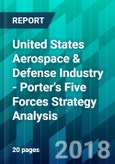“Aerospace” is the broader term that includes activities related to manmade flight in the earth’s atmosphere and outer space. The U.S. Department of Defense (DoD) defines “aerospace” as “of or pertaining to Earth's envelope of atmosphere and the space above it; two separate entities considered as a single realm for activity in launching, guidance, and control of vehicles that will travel in both entities.” “Aviation” is a subset of “aerospace,” referring to activities related to manmade flight within earth’s atmosphere.
The publisher analyzes the United States Aerospace & Defense Industry in Michael Porter’s Five Forces Analysis. It uses concepts developed in Industrial Organization (IO) economics to derive five forces that determine the competitive intensity and therefore attractiveness of a market. Porter referred to these forces as the microenvironment, to contrast it with the more general term macro-environment. They consist of those forces close to a company that affect its ability to serve its customers and make a profit. A change in any of the forces normally requires a company to re-assess the marketplace.
The publisher analyzes the United States Aerospace & Defense Industry in Michael Porter’s Five Forces Analysis. It uses concepts developed in Industrial Organization (IO) economics to derive five forces that determine the competitive intensity and therefore attractiveness of a market. Porter referred to these forces as the microenvironment, to contrast it with the more general term macro-environment. They consist of those forces close to a company that affect its ability to serve its customers and make a profit. A change in any of the forces normally requires a company to re-assess the marketplace.
Table of Contents
A. Executive SummaryB. Introduction to the Industry
B.1 Industry Definition
B.2 Industry Profile
B.3 Future Outlook
C. Porter’s Five Forces Strategy Analysis
C.1 Bargaining Power of Buyers
C.2 Bargaining Power of Suppliers
C.3 Competitive Rivalry in the Industry
C.4 Threat of New Entrants
C.5 Threat of Substitutes
D. Conclusion
E. Glossary of Terms








